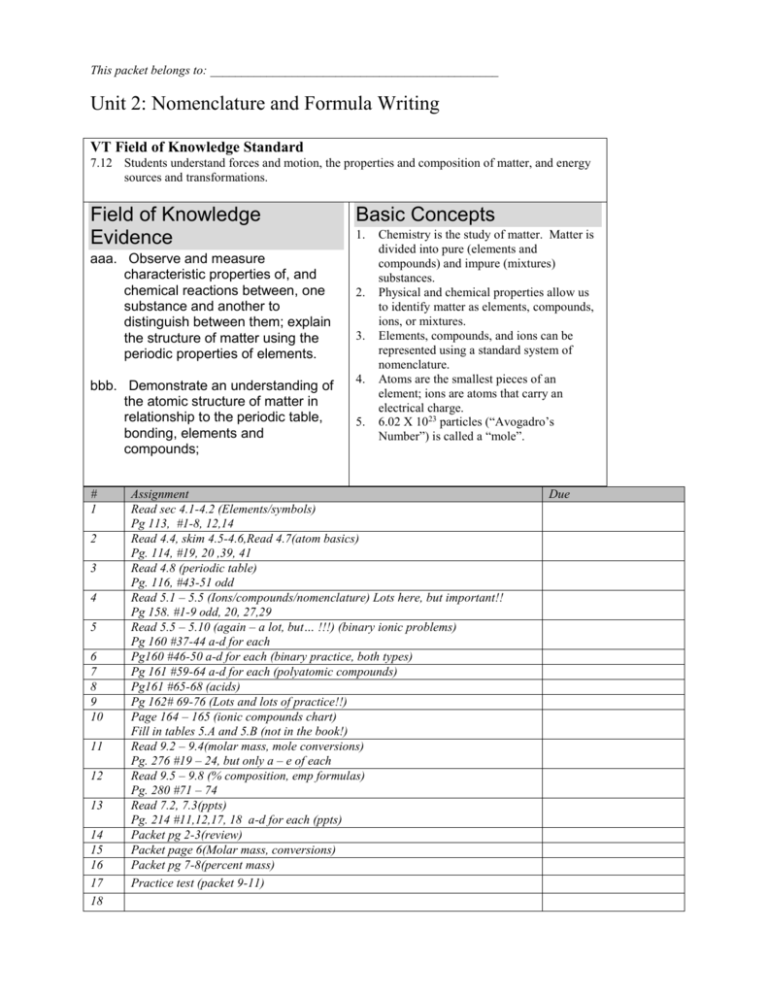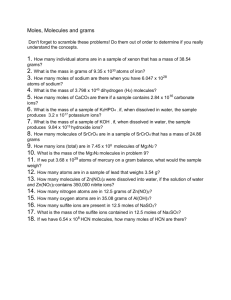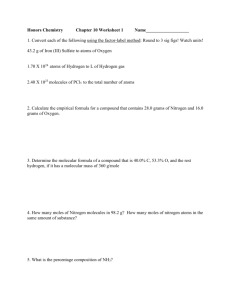Name
advertisement

This packet belongs to: ______________________________________________ Unit 2: Nomenclature and Formula Writing VT Field of Knowledge Standard 7.12 Students understand forces and motion, the properties and composition of matter, and energy sources and transformations. Field of Knowledge Evidence aaa. Observe and measure characteristic properties of, and chemical reactions between, one substance and another to distinguish between them; explain the structure of matter using the periodic properties of elements. bbb. Demonstrate an understanding of the atomic structure of matter in relationship to the periodic table, bonding, elements and compounds; # 1 2 3 4 5 6 7 8 9 10 11 12 13 14 15 16 17 18 Basic Concepts 1. 2. 3. 4. 5. Chemistry is the study of matter. Matter is divided into pure (elements and compounds) and impure (mixtures) substances. Physical and chemical properties allow us to identify matter as elements, compounds, ions, or mixtures. Elements, compounds, and ions can be represented using a standard system of nomenclature. Atoms are the smallest pieces of an element; ions are atoms that carry an electrical charge. 6.02 X 1023 particles (“Avogadro’s Number”) is called a “mole”. Assignment Read sec 4.1-4.2 (Elements/symbols) Pg 113, #1-8, 12,14 Read 4.4, skim 4.5-4.6,Read 4.7(atom basics) Pg. 114, #19, 20 ,39, 41 Read 4.8 (periodic table) Pg. 116, #43-51 odd Read 5.1 – 5.5 (Ions/compounds/nomenclature) Lots here, but important!! Pg 158. #1-9 odd, 20, 27,29 Read 5.5 – 5.10 (again – a lot, but… !!!) (binary ionic problems) Pg 160 #37-44 a-d for each Pg160 #46-50 a-d for each (binary practice, both types) Pg 161 #59-64 a-d for each (polyatomic compounds) Pg161 #65-68 (acids) Pg 162# 69-76 (Lots and lots of practice!!) Page 164 – 165 (ionic compounds chart) Fill in tables 5.A and 5.B (not in the book!) Read 9.2 – 9.4(molar mass, mole conversions) Pg. 276 #19 – 24, but only a – e of each Read 9.5 – 9.8 (% composition, emp formulas) Pg. 280 #71 – 74 Read 7.2, 7.3(ppts) Pg. 214 #11,12,17, 18 a-d for each (ppts) Packet pg 2-3(review) Packet page 6(Molar mass, conversions) Packet pg 7-8(percent mass) Practice test (packet 9-11) Due Nomenclature Practice 1. 2. In which group do the following substances belong? Your choices are 1) metallic element, 2) non-metallic element, 3) compound, 4) heterogeneous mixture, and 5) homogeneous mixture. a. beach sand b. silicon dioxide c. aluminum foil d. ginger ale e. air f. copper(II) sulfate g. quartz h. granite i. NaCl solution j. milk Give the formula or name of the following: a. calcium nitrate b. lead(IV) carbonate c. ammonium hydroxide d. zinc oxide e. copper(I) sulfite f. copper(II) sulfite g. NaBr h. KI i. MgO j. BaCl2 k. N2O l. N2O4 m. PCl3 n. P4O10 5. A cheetah is able to run at a speed of 60 miles/hour. Use dimensional analysis only to answer this question: how many meters can a cheetah run in 30 seconds? 6. Write the names of the following compounds. a. Na3PO4 b. (NH4) 2CO3 c. d. Al2O3 MgS 2 7. Write the correct formula for the following compounds. a. copper(II) carbonate b. silver nitrate c. magnesium phosphate d. ammonium chloride 8. Two clear solutions are mixed in a test tube, and a white precipitate forms. The first solution is barium iodide. The second solution is potassium phosphate. KI is soluble in water. Write the formula of the precipitate. [You will need to use your solubility rules.] 9. Suppose that every milliliter of seawater contains 35 mg of NaCl. How many grams of sodium chloride are in 10.0 gallons of seawater? Express your answer in scientific notation. 10. Name 'em. a. Al2S3 b. CS2 c. CoCl2 · 6H2O d. SnCO3 e. BF3 f. SiF4 g. KMnO4 h. N2O4 i. (NH4) 2S 11. Write the formulas for the following acids: a. hydrobromic acid b. chloric acid d. phosphoric acid e. hydrosulfuric acid g. perchloric acid h. acetic acid c. nitric acid f. hydrocyanic acid 3 j. NH3 Mole Conversions, Percent Composition, and Finding Formulas Key things to remember: 1. 2. 3. 4. 1 mole=Avogadro’s # = 6.022 x 1023 = really big number 1 mole of any substance weighs its molar mass in grams When in doubt, ALWAYS change to moles. When confused, use dimensional analysis to get to a desired unit. To find molar mass 1. Find or use a correct molecular formula. 2. Use atomic weight of each substance to determine molar mass. Example: Fe2O3 Fe = 55.85 g O = 16.00 g There are 2 iron atoms and 3 oxygen atoms. Therefore: 55.85(2) + (16.00)3 = 159.7 g/mol To convert to moles, given grams 1. Find the molar mass of the substance 2. Use dimensional analysis to find moles Example How many moles is 247.3 g of iron (III) oxide? The molar mass of Fe2O3 = 159.7 g/mol (from previous example) 247.3 g * 1 mol = 1.549 moles 159.7 g * notice that the units cancel to get moles To convert to grams, given moles 1. Find the molar mass of the substance 2. Use dimensional analysis to find the grams Example How many grams is 5.032 moles of Fe2O3? Fe2O3 = 159.7 g/mol 5.032 mol * 159.7 g = 803.61 g Fe2O3 1 mol 4 To figure out number of molecules or atoms 1. Convert to moles of the substance 2. Multiply moles times Avogadro’s number Example: How many molecules of iron (III) oxide are in the last problem? 5.0322 moles * 6.022 * 1023 = 3.029 x 1024 molecules Fe2O3 To convert to atoms 1. Same as above, but use ratio of atoms to molecules first 2. Then multiply moles times Avogadro’s number 3. When in doubt, dimensional analysis! How many moles of O atoms in 5.032 moles of Fe2O3? 5.032 moles Fe2O3 * 3O * 6.022 *1023 1 Fe2O3 1 mole = 9.091 * 1024 atoms O To find percent composition of a compound 1. Find molar mass of the compound 2. Find mass of each constituent of the compound using atomic mass and number of atoms of each. 3. Divide constituent mass by molar mass and multiply by 100 (% = part/whole * 100) 4. The check is to be sure percents add to 100% What is the % composition of Fe2O3? Fe2O3 = 159.7 g/mol 2 Fe atoms 3 O atoms 2 Fe = 55.847 * 2 = 111.694 g / 159.7 g * 100 = 69.94 % 3 O = 16.00 * 3 = 48.00 g / 159.7 g * 100 = 30.06 % Check: 69.94 + 30.06 = 100 To find the formula of a compound, given percent 1. 2. 3. 4. 5. Assume that there is 100 g of the compound. Therefore 100% of it = 100 g Change percents to g Change grams to moles Find the ratios of the moles, in whole numbers. (Do this by dividing all moles by the smallest # of moles) Put whole numbers into the molecular formula. 69.94 % Fe = 69.94 g Fe * 1 mole = 1.252 moles 55.847 g 30.06 % O = 30.06 g O *1 mole = 1.879 moles 16.00 g 5 1.252 to 1.879 = 1 to 1.5 to get to whole numbers, double them both, so that there are 2 Fe to 3O Moles, Molecules, and Grams Worksheet 1) How many molecules are there in 24 grams of FeF3? 2) How many grams are there in 7.4 x 1023 molecules of AgNO3? 3) How many molecules are there in 122 grams of Cu(NO 3)2? 4) How many grams are there in 9.4 x 1025 molecules of H2? 5) How many molecules are there in 2.3 grams of NH4SO2? 6) How many molecules are there in 200 grams of CCl 4? 7) How many grams are there in 4.5 x 1022 molecules of Ba(NO2)2? Name 8) A karat is a measure of purity of gold for jewelry. 24 k is pure gold, with anything less related to the ratio of other metals mixed in. For example a 5 karat necklace is 5 parts gold out of 24 total parts. How many moles and molecules of gold are there in a 4.05 gram earring made from 18 karat gold? 9) Find the mass percent of each constituent for the compound barium nitrate. 10) Determine the formula for a compound that, when decomposed, is 1.00 g of Ba and 0.1117 g of O. (Sample problem, page 268 in text) Most scrambled answers (note: sig figs are inconsistent and at times wrong…): 7.82 x 1023 molecules 421 grams 209 grams 1.69 x 1022 molecules 312 grams 3.92 x 1023 molecules 1.28 x 1023 molecules 1.33 x 1023 molecules 1.91 x 1024 molecules 122 grams 1.07 x 1024 molecules 430 grams 195 grams 3.96 x 10 24 molecules 17.1 grams 2.51 grams 6 Name Percentage Mass 1. 2. Determine the formula and name of the following substances, given their percent compositions and molar masses. a. 64% Fe; 36% S; molar mass = 88 b. 41% Cu; 18% N; 41% O; molar mass = 155.5 c. 40% S; 60% O; molar mass = 80 d. 2% H; 33% S; 65% O; molar mass = 98 e.100% O; molar mass = 48 f. 65% Ag; 16% Cr; 19% O; molar mass = 332 A student is attempting to experimentally determine the formula for a compound consisting of the elements mercury and oxygen. The compound is an orange powder which, when heated, undergoes a "decomposition" reaction -- it falls apart. Initially, the mercury and the oxygen are joined together by chemical bonds, and heat causes the bonds to break, and oxygen is thus separated from the mercury. Here is the data collected for the experiment; you finish it. mass of test tube mass of test tube + orange powder mass of test tube after heating* 14.564 g 14.981 g 14.951 g *After heating, the inside of the test tube was coated with a mirror-like, silvery finish, which collected in small liquid beads eventually. mass of the orange powder _______ mass of the mercury in the compound _______ mass of the oxygen in the compound _______ % mercury in the compound _______ % oxygen in the compound _______ Empirical Formula for the compound _________ 7 3. Use dimensional analysis. a. If you had 14.54 grams of NaCl, how many moles would you have? (1 step) b. How many molecules of sulfur dioxide are in 100 grams of the gas? (2 steps) c. What is the mass of exactly one atom of hydrogen? (2 steps) d. The formula for anhydrous iron(III) sulfate will tell you how many atoms of oxygen are in every molecule of the compound. If you had 0.237 moles of iron (III) sulfate, how many atoms of oxygen would you have? 8 Practice Nomenclature and Formulas and Moles and Composition Test Choose the best answer for the following multiple choice questions. 2 pts each. ____ 1. The correct name for K2S is: a. potassium sulfate b. dipotassium monosulfide c. potassium sulfide d. potassium monosulfide ____ 2. In general, it can be said that: a. non-metals become positive ions b. non-metals lose electrons to become ions c. non-metal ions are always negative d. all of the above e. none of the above ____ 3. Something that is covalently bonded: a. Is a metal bonded to metal b. contains only ions c. donates electrons d. is a nonmetal bonded to a nonmetal ____ 4. Iodine forms an ion with a charge of: a. +1 b. +7 c. –2 d. –1 ____ 5. Which of the following is not ionic? a. NaCl b. magnesium permanganate ____ 6. In naming, the Roman numeral is used to: a. Indicate the charge on the metal c. indicate the charge on the non-metal c. sulfur tetrafluoride d. Al2O3 b. indicate how many metal ions are present d. tell how many electrons are gained ____ 7. What is the percent composition of C in methane, CH 4? a. 25% b. 133% c. 75% d. 92% ____ 8. There are ____ atoms of nitrogen in 10 g of NH 4NO3? a. 3.5 b. 1.5 x 1023 c. 7.5 x 1022 d. 1.8 e. 7.7% e. 2 ____ 9. How many moles of carbon dioxide are there in 52.06 g of carbon dioxide? a. 0.8452 b. 1.183 c. 6.022 x 1023 d. 8.648 x 1023 ____ 10. An unknown element X forms compounds with ferricyanide ions which have the following formulas: X3[Fe(CN) 6] 2 and XFe(CN) 6. Which of the following is a possibility for element X? a. copper b. lead c. sodium d. iron 11. Write the names of all the following compounds, the type of compound it is, and determine the molar mass. Don’t forget units! (1 pt each, 18 total) Formula a. H3PO4 Name b. Sulfur dioxide Molar mass c. Al2S3 d. Iron (II) sulfate e. ZnCr2O7 f. Hydrobromic acid 9 Ionic/covalent/acid? 12. Write the formula or give the name for the following: (2 pts each) a. sulfurous acid b. CBr4 c. lead (IV) sulfate d. copper (I) sulfite penta hydrate e. dinitrogen tetroxide f. Li(OH)2 g. sulfurous acid h. H3P For the rest of the problems, show all work. 13. Consider allicin, C6H10OS2, the chemical responsible for the small of garlic: a. What is the molar mass of allicin (2 pts): b. What is the mass percent of the carbon in allicin? (4 pts) c. If a clove of garlic contains 0.0013 grams of allicin, how many moles is this? (4 pts) d. How many atoms of sulfur are there in part c? (4 pts) 14. If a penny weighs 2.50 grams, and is 2.5% copper, how many moles of copper are in one penny? (Find grams Cu first.) 6 pts 10 15. 1.384 moles of Ba(OH)2 weighs how much, in grams? 4 pts 16. A compound analyzed by mass spectrometer is determined to have 40.0% carbon, 6.7% H, and 53.3% oxygen. The molecular mass of the compound is 180 g/mol. What are the empirical and molecular formulas for the compound? 6 pts 17. An unlabeled bottle is left out on the lab table. The last lab only used barium nitrate, silver nitrate, and iron (II) nitrate, so the unknown solution must be one of these. Devise an experiment that could identify the cation that is contained in the solution. Write out the steps, including any reaction equations that could occur. The bottle contains only one cation. (10 pts) Solubility of common ions in water 1. Nitrate salts are soluble. 2. Salts of Na, K, and NH4 ions are soluble. 3. Most halide (Cl, Br, I) salts are soluble. Exceptions: Ag+, Pb2+4. 4. Most sulfate salts are soluble. Except: BaSO4, PbSO4, CaSO4 5. Most hydroxide compounds are insoluble. Soluble hydroxides include NaOH, KOH, and Ca(OH)2 6. Most sulfide, carbonate, and phosphate salts are insoluble. Exceptions: Rule 1 and 2 ions 11 Solubility Rules for Common Ions in Solution In many reactions between ions, a precipitate can form. A precipitate is when a solid forms in solution. A precipitate is an insoluble form of a salt. Precipitates do not always form when ions interact. The rules listed below can help to determine if a precipitate forms, and what the formula for the precipitate is. Usually Soluble 1. All chlorates, nitrates and acetates are soluble. 2. Salts of group I compounds (H+, Na+, Li+, K+, Rb+, Cs+) and ammonium (NH4+) are soluble. 3. Halides (Cl-, Br-, I-) are soluble, except for those of silver, lead (II) and mercury (I) ions. 4. Sulfates are soluble except for those of mercury (I), lead (II), barium, and strontium ions. 5. Nitrites are soluble except for silver nitrite. Usually insoluble 6. Carbonates, phosphates and oxides are all insoluble except ions in rule 2. 7. Fluorides are insoluble, except for silver, iron (III) and the ions in rule 2. 8. Sulfides and hydroxides (OH-) are insoluble, except for strontium, barium and the ions in rule 2. 12




